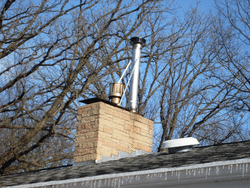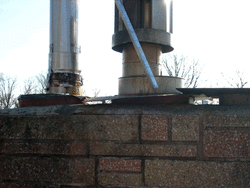Today was another CO event.......
We have been runnning for a few days, then shutting down to no coals an starting again since the levels have typically happened on day 4-5.
This am, we were down to just a little bit of coals, after running it for about 4 days, and my husband started the fire at 9:50am with small kindling, paper and wood. The damper was wide open. He got everything set, lit the paper, closed the door right away, and took readings before and after and it was zero.
At 10:45, he went downstairs, levels were zero, put in another log once the fire had been really going (He left the damper open for that hour to really clean out the chimney), and readings remained zero. He closed the damper completely (he doesn't do the fire often and thought he was supposed to do that) and came up, I sent him back down when he told me what he did, and read it and it was zero (about 20-30 minutes later). It was then opened to 1/4 open which is where is usually is during normal running operation. At 11:40, he was going to leave for an appointment so he went down to put in one more big log. The detector was at 20 before opening up the door (which is where it usually starts when we start having issues).
Winds are out of the N/NW today but snowflakes are falling at just a slight angle, not at a hard angle to indicate strong winds. There isn't swirling by the vents, either. The snow in that area is falling very calmly.
There were two showers this morning, like every morning. The fan ran for 20 minutes at 7am in the bathroom. No laundry today, no dishes, no stove exhaust, no changes from life as it is every day here (except my hubby was home today for that appointment). On the other days, he did not do the fire; it was me, so I can't blame this all on him, either

!



hee hee
The HVAC man said that our air exchanger is 10 feet away from intakes and that meets code and the intake was installed in the NW most part of the home for our part of the country. (He didn't do this system, but he said the venting here is not a concern based on the measurements)
The levels are back to zero, but on the fire chief's handheld, he would measure consistent readings at different points even when the numerical readout would say zero....that is baffling. I have not called him today.......just trying to record everything. I didn't open anything up to air out the house so if my upstairs detectors go off, I'll call him to come out and do readings.
The HVAC guy is doing a search with his sister companies to find a long term metering CO detector for us to use.
Our fireplace guy has not been in touch with us for a week and a half now, even after I left messages. No word on a camera or about a pipe to put up there...... nothing.
I appreciate that someone offered to drive here to help but we are two hours away from him. I just would feel so bad that he would do that. It wouldn't be such a big deal, to just pay someone to come and try to get this all figured out, but we have really awful health insurance and nearly $8,000 in bills we are struggling to pay right now on top of everything else. When it rains, it pours.
So we did the HVAC thing and the CO detector inside the gas fireplace and now we need to get a new pipe on one of those flues for the chimney. Are we in agreement that it is the woodstove pipe that should be higher?
Thanks again!

WI GIRL


 !
! 

